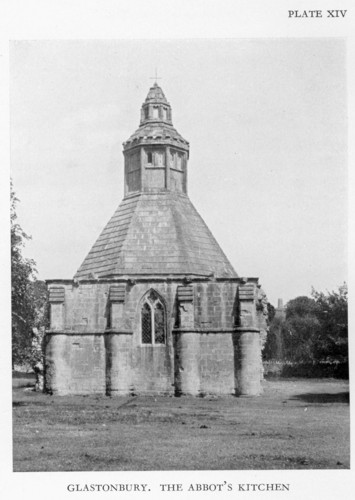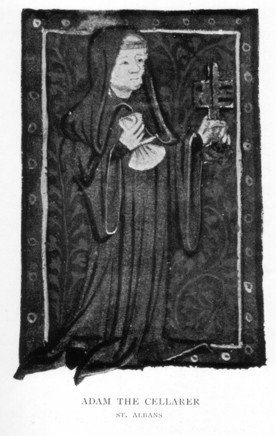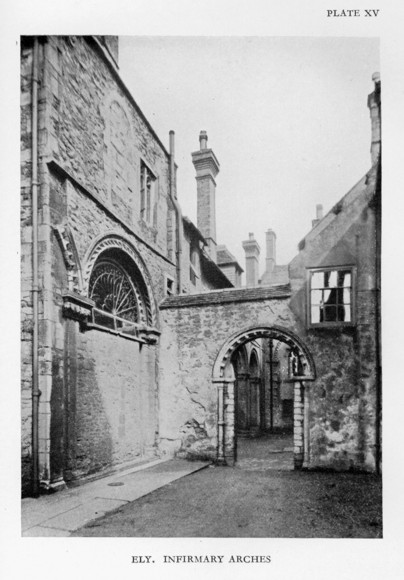
(go to Abbey Pages Home)
(go to Monastic Pages Home)
(go to Historyfish Home)
Leave a Comment
 |
<<Back
to Parts of a Monastery. (go to Abbey Pages Home) (go to Monastic Pages Home) (go to Historyfish Home) Leave a Comment |
 |
 Cloister and
Living Quarters in a Medieval Monastery
Cloister and
Living Quarters in a Medieval Monastery| The
parts and functions of the Medieval Monastery, using the groundplan for
Beaulieu
Abbey as a basemap. Return to the Parts
of a Monastery page to view the map, room labels, and basic
information about the abbey. Scroll
down for individual explanations of the basic rooms, parts, and
functions of a medieval abbey. For information about the
parts of the abbey church, see Parts of the Church. |
| Living Quarters
(Scroll Down) Monks Frater and Lay Frater (Refectory) The Kitchen The Cellars The Infirmary (and Misericorde) Calefactory (Common Room or Warming House) |
Living Quarters (next page) Monks Dorter and Lay Dorter The Lavatory Parlour The Cloister Chapter House Fish Ponds and Grounds |
|
|
 |
Shared meals in
a monastery were as
ritualistic as all other
parts of the religious life. In
monasteries, such as Beaulieu, where there lived Lay Brothers as well
as Ordained Monks, the ritual of mealtime was kept separately, and each
group had their own washing sink and dining hall, though both were
served by the same kitchen. Only one meal was served per day, and for that meal the monks processed from the church through the cloister to the refectory, underwent washing at the lavatory sinks, washing their hands, faces, and knives, and then, when the Kitchener (and cook) announced the meal was ready, they processed into the frater. They sang psalms before and after taking their meal, which was always served with a loaf of bread, this signifying the sharing of bread among Christians. No talking was permitted, every monk instead listened to the Reader who read a scripture from the pulpit in the refectory. Sometimes talking was allowed, but then only very quietly as necessary between the prior or abbot and his guests. Any food left uneaten at the end of the meal was taken into a basket and given to the poor. In addition, one extra meal was always prepared and one poor man chosen to come into the refectory to receive it. |
| |
 Image from English Monastic Life F.A.Gasquet, 1904 |
|
| From English
Monastic Life, by F.A.
Gasquet:
"The refectory, sometimes called the fratry or frater-house, was the common hall for all conventual meals. Its situation in the plan for a monastic establishment was almost always as far removed from the church as possible, that is, it was on the opposite side of the cloister quadrangle and, according to the usual plan, in the southern walk of the cloister. The reason for this arrangement is obvious. It was to secure that the church and its precincts might be kept as free as possible from the annoyance caused by the noise and smells necessarily connected with the preparation and consumption of the meals. "As a rule, the walls of the hall would no doubt have been wainscotted. At one end, probably, great presses would have been placed to receive the plate and linen, with the salt-cellars (salt dispenser), cups and other ordinary requirements of the common meals. The floor of a monastic refectory was spread with hay or rushes, which covering was changed three or four times in a year ; and the tables were ranged in single rows lengthways, with the benches for the monks upon the inside, where they sat with their backs to the paneled walls. At the east end, under some sacred figure, or painting of the crucifix, or of our Lord in glory, called the Majestas, was the mensa major, or high table for the superior. Above this the Scylla or small signal-bell was suspended. This was sounded by the president of the meal as a sign that the community might begin their refection, and for the commencement of each of the new courses. The pulpit, or reading-desk, was, as a rule, placed upon the south side of the hall, and below it was usually placed the table for the novices, presided over by their master. |
||
 Image from English Monastic Life F.A.Gasquet, 1904 |
||
|
"Amongst the
other weekly officials may be noted the servers
and the readers at meals. These brethren could take something to
eat and
drink before the community came to the refectory, in order the better
to be
able to do their duty. The reader was charged very strictly
always to
prepare what he had to read beforehand and to find the places, so as to
avoid
all likelihood of mistakes. He was to take the directions of the
cantor (liturgist)
as to pronunciation, pitch of the voice, and at the rate at which he
was to
read in public. If he were ill, or for any other reason was
unable to
perform his duty, the cantor had to find a substitute. "The servers
began
their week of duty by asking a blessing in church on Sunday
morning. They were at the disposal of the refectorian during
their period
of service, and followed his directions as to waiting on the brethren
at meal
times, preparing the tables, and clearing them after all had
finished." |
||
|
The monastic kitchens were
overseen
by the
Much ritual surrounded the serving of food, what type must be served, and in what amounts. In some institutions, servings were carefully measured on plates beforehand, and in others, communal plates were placed on the table and eaten in a manner similar to that of the manor house, from shared plates. The work of the kitchen tended to be segregated according to what needed to be prepared and the quantity of food needed. In a larger monastery, the main kitchen would be used primarily for making pottage, sauces, custards, and roasting meats. Bread and pastry (such as for pies) would be baked in a separate kitchen, with the bread of the communion baked in a sacred space set aside for that purpose, perhaps in the kitchens, but perhaps also in an area of the church itself. |
||
 Image from The Home of the Monk,
by Rev. D.H.S. Cranage, 1926 |
||
| Yet another
kitchen would serve the
monastery servants and guests those who had come on pilgrimage or
seeking
charity (alms) or rest (such as the infirm, should the monastery
include a
hospital). This kitchen would be
located on the grounds, but not within the gates of the cloister. Important guests would be served from
the
monastery kitchen itself, and infirm monks who lived within the
cloister might also have a separate kitchen to serve them. Butchering and
cleaning of animals would be done away from the monastery gates. Beverages were not the domain of the kitchen, but instead were prepared and stored in the buttery. (Many beer concoctions included things like milk, eggs, sugar, spices and butter. A raw egg in warmed beer was common. Yum.) Some monasteries also had a brewhouse for brewing ale or beer, or cellars for fermenting wine, or even distilleries for making the quintessential spirits. Though it was not only liqueur which was distilled. Monks experimented with the distillation of many things, including chickens. |
||
|
The cellars were the storeroom of the
monastery, and was used
for storing most everything used to upkeep the house, from salt for
preserving meat and for the table salt cellars, to
beeswax for
the altar candles. The Cellarer was the
official in charge of procuring almost all that was needed to run the
‘household’ of the monastery smoothly. His charge
extended to the manors and farmland of the monastery, the tithe barns,
and other duties of storage and procurement. The duties of the
Cellarer, according to F.A.
Gasquet in English Monastic
Life, were: "Besides
the main part of this office as caterer to the community, on the
cellarer
devolved many other duties. In fact, the
general management of the establishment, except what was specially
assigned to
other officials, or given to any individual by the superior, was in his
hands. In this way besides the question
of food and drink, the cellarer had to see to fuel, the carriage of
goods, the
general repairs of the house, and the purchases of all materials, such
as wood,
iron, glass, nails, etc. |
||
 Image from English Monastic Life
F.A.Gasquet, 1904 |
||
|
"Some
of the Obedientiary accounts (Officer's accounts) which have survived
show the multitude and
variety
of the cellarer’s cares. At one time, on
one such Roll, beyond the ordinary expenses there is noted the purchase
of
three hundred and eighty quarters of coal for the kitchen, the carriage
of one
hundredweight of wax from London, the process of making torches and
candles,
the purchase of cotton for the wicks, the employment of women to make
oatmeal,
the purchase of “blanket-cloth” for jelly strainers, and the employment
of “the
pudding wife” on great feast days to make the pastry.
He had, of course, frequently to visit the
granges and manors under his care, to look that the overseer knew his
business
and did not neglect it, to see that the servants and labourers did not
misconduct themselves, and that the shepherds spent the nights watching
with
their flocks, and did not wander off to any neighbouring tavern. Besides this he was charged to see that the
granary doors were sound and the locks in good order, and in the time
of
threshing out the corn he was to keep watch
over the men engaged in the work and the women who
were winnowing."
|
||
The Infirmary The infirmary at any monastery served as a place to care for the sick, the elderly, and those who needed rest. Medicines and special foods were provided, but much more importantly, the infirmary served as a place where the seriously ill monk or nun would receive assistance in preparing their soul for death. Care of the infirm and sick was considered of the highest moral importance, and, in Christ’s example of His own care of the weak and sick, the abbot himself was instructed to visit the ailing every day to comfort and encourage them, as well as to make sure that their needs were being properly met. (Monasteries also often founded and supported hospitals near to the monastery--but not within the cloister--for permanently disabled, or elderly poor men and/or women. These hospitals could also serve as places of temporary rest. Christians of the time believed in Christ's exhortation to his followers that care of the sick constituted a primary moral obligation: ‘Truly I tell you, just as you did it to one of the least of these my brothers, you did it to me." Matthew 25:40.) |
||
 Image from English Monastic Life F.A.Gasquet, 1904 |
||
|
Additionally, the infirmary was
a place to
support recuperation
and relaxation. Under the guidance of
the Infirmarian, the duties and responsibilities of the communal life
could be
relaxed a little. Those suffering from a ‘weariness’ brought on
by
the strictures of the Rule and the observance
of the Hours could find calm and return to their duties with renewed
devotion. Some think that this is why the
tradition of
regular bleeding endured in monasteries, because the four days rest it
offered
were welcomed.
For those who
required an
emotional rest (perhaps suffering
from depression, or other form of emotional or intellectual fatigue) or
for
those who were to rest after being blooded (see CALEFACTORY), while
they were
under the care of the infirmarian, they usually did not stay in the
infirmary. The remedy for both emotional
weariness and ritual bleeding was quiet rest, opportunity for
reflection, and,
in the case of the weary, walks in the open air. As
such, these patients remained in the
dorter, or dormitory. Their duties, however, were
eased, and repose in the Chapter House, Calefactory or dorter was
encouraged. Those who had been blooded took their meals in the
misericorde, which was the infirmary frater (or dining room). |
||
 Image from
The Home of the Monk, by Rev. D.H.S. Cranage, 1926 |
||
| The infirmary also served as a retirement community for monks who were no longer able to keep up their duties to the house because they had slipped into weakness, senility, or dementia (and so could not keep silent). Though the elderly monks were still required to keep the rule as they were able, things were easier and primary importance was placed on their spiritual needs and bodily comfort. As such, the Infirmary could become a community within a community. It had its own frater (dining room) called the misericorde, an attached chapel for celebrating Mass and reciting the Hours, and was supplied by its own kitchens (sometimes called a meat kitchen), which produced easily digestible foods (such as bread soaked in mare's milk), and foods to strengthen those who had been blooded. | ||
| The Calefactory, also called the Warming House or Common Room, was a place for the monks to relax together, and, in winter, enjoy the benefit of a hot fire, especially after night offices. Monks had specially issued ‘night boots’ and robes so that they could be as warm as possible, but the churches were large and unheated and often drafty. After the night and early morning offices, they were allowed time to congregate together by the fire and warm up. Monks also
practiced ritual bleeding where two to six monks
at a time (depending on the size of the house) were bled by the
Infirmarian, or
someone qualified to perform the procedure. Being
blooded was considered a health regimen, and it was
thought to
purge the body of impurities. (Perhaps in
the days when heavy metals (such as lead and mercury) were used in
plate
glazing and water pipes, periodic bleeding helped purge the body of
this metal
buildup? It seems there must have been some type of benefit,
either known or unknown, to the procedure.) Each monk was blooded once a year, or occasionally twice, on a rotating basis. Strict rules followed all aspects of the ritual. The operation took place during the afternoon in the Calefactory (common room or warming house) by a warm fire with a styptic and a basin. After, the monk’s arm was wrapped tightly in bandages and for four days he was excused any activity that would risk a resumption of the bleeding, such as too much standing or kneeling, or any activity where the bandages might be accidentally brushed or bumped. The monk was excused choir duties (though he was still expected to attend the offices) and, though he still had to wake up during the night for prayer, he could go to the infirmary chapel instead of the church, where the service was quicker and simpler. An easier schedule in general was allowed, rest encouraged, and foods such as an extra egg and beef broth, were given to help build strength. |
||
To Living Quarters in the Monastery, page two>> <back to top> |
| Historyfish
pages, content, and design copyright (c) Richenda
Fairhurst, 2008 All rights reserved. No commercial permissions are granted. The Historyfish site, as a particular and so unique "expression," is copyright. However, some (most) source material is part of the public domain, and so free of copyright restrictions. Where those sections are not clearly marked, please contact me so I can assist in identifying and separating that material from the Historyfish site as a whole. When using material from this site, please keep author, source, and copyright permissions with this article. Historyfish intends to generate discussion through shared information and does not claim to provide, in any way, formal, legal, or factual advice or information. These pages are opinion only. Opinions shared on historyfish are not necessarily the opinions of historyfish editors, staff, owners or administrators. Always consult proper authorities with questions pertaining to copyrights, property rights, and intellectual property rights. It is my intent to follow copyright law (however impossibly convoluted that may be). Please contact me should any material included here be copyright protected and posted in error. I will remove it from the site. Thank you.  |